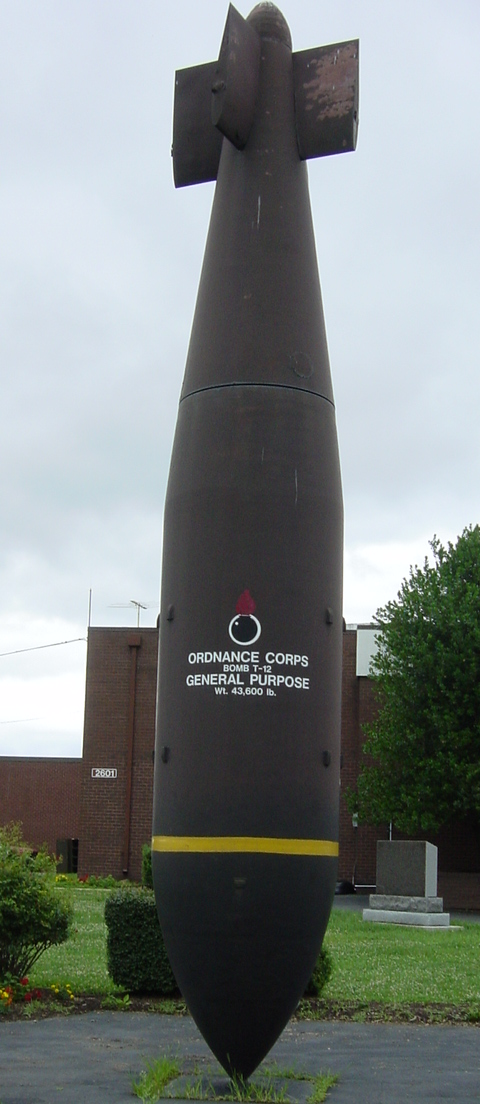T-12 Cloudmaker on:
[Wikipedia]
[Google]
[Amazon]
 The T-12 (also known as Cloudmaker)
The T-12 (also known as Cloudmaker)
"Big Bomb Tight Fit In B-29 Bomb Bays"
''Popular Science'', October 1951, p. 144. Photo showing T-12 being fitted to B-29 bomb bay
"The USA's 30,000 Pound Bomb", ''Defense Industry Daily''
Article on the new Massive Ordnance Penetrator (MOP), has history of earlier systems.
by Dr. William S. Coker. ''Air University Review'', March-April 1967. Anti-fortification weapons Cold War aerial bombs of the United States
earthquake bomb
The earthquake bomb, or seismic bomb, was a concept that was invented by the British aeronautical engineer Barnes Wallis early in World War II and subsequently developed and used during the war against strategic targets in Europe. A seismic bomb ...
was developed by the United States from 1944 to 1948 and deployed until the withdrawal of the Convair B-36 Peacemaker
The Convair B-36 "Peacemaker" is a strategic bomber that was built by Convair and operated by the United States Air Force (USAF) from 1949 to 1959. The B-36 is the largest mass-produced Reciprocating engine, piston-engined aircraft ever built. It ...
bomber aircraft in 1958. It was one of a small class of bombs designed to attack targets invulnerable to conventional "soft" bombs, such as bunker
A bunker is a defensive military fortification designed to protect people and valued materials from falling bombs, artillery, or other attacks. Bunkers are almost always underground, in contrast to blockhouses which are mostly above ground. T ...
s and viaduct
A viaduct is a specific type of bridge that consists of a series of arches, piers or columns supporting a long elevated railway or road. Typically a viaduct connects two points of roughly equal elevation, allowing direct overpass across a wide va ...
s. It achieved this by having an extremely thick, hardened nose section designed to penetrate deeply into hardened concrete structures and then detonate inside the target after a short time delay.
Development
The T-12 was a further development of the concept initiated with the United Kingdom's Tallboy and Grand Slam weapons developed by British aeronautical engineerBarnes Wallis
Sir Barnes Neville Wallis (26 September 1887 – 30 October 1979) was an English engineer and inventor. He is best known for inventing the bouncing bomb used by the Royal Air Force in Operation Chastise (the "Dambusters" raid) to attac ...
during the Second World War
World War II or the Second World War, often abbreviated as WWII or WW2, was a world war that lasted from 1939 to 1945. It involved the World War II by country, vast majority of the world's countries—including all of the great power ...
: a hardened, highly aerodynamic bomb of the greatest possible weight designed to be dropped from the highest possible altitude. Penetrating deeply in the earth before exploding, the resulting shock wave was transmitted through the earth into targets. The resulting underground cavity and ground motion could also undermine structures. The bomb could also be used against hardened targets. These types of bombs can reach supersonic speeds and have tail fins designed to spin the bomb for greater accuracy.
Originally designed to meet a target weight (one half of the maximum payload for the Convair B-36 "Peacemaker" bomber), with its hardened case was slightly less than . The final T-12 weighed . This was twice the size of the United States' previous largest bomb, the M110 (T-14), the American-built version of the British Grand Slam. The T-12 was not a simple scale up of the M110, but incorporated modifications based on testing and calculations. The B-36 was redesigned so it could carry the T-12, although a converted B-29 Superfortress
The Boeing B-29 Superfortress is an American four-engined propeller-driven heavy bomber, designed by Boeing and flown primarily by the United States during World War II and the Korean War. Named in allusion to its predecessor, the B-17 ...
was used for testing.
See also
* Aviation Thermobaric Bomb of Increased Power *BLU-82
The BLU-82B/C-130 weapon system, known under program "Commando Vault" and nicknamed " Daisy Cutter" in Vietnam for its ability to flatten a section of forest into a helicopter landing zone, is an American conventional bomb, delivered from eith ...
* Bunker buster
* Grand Slam bomb
* Massive Ordnance Penetrator
* MOAB
References
External links
{{Commons category"Big Bomb Tight Fit In B-29 Bomb Bays"
''Popular Science'', October 1951, p. 144. Photo showing T-12 being fitted to B-29 bomb bay
"The USA's 30,000 Pound Bomb", ''Defense Industry Daily''
Article on the new Massive Ordnance Penetrator (MOP), has history of earlier systems.
by Dr. William S. Coker. ''Air University Review'', March-April 1967. Anti-fortification weapons Cold War aerial bombs of the United States